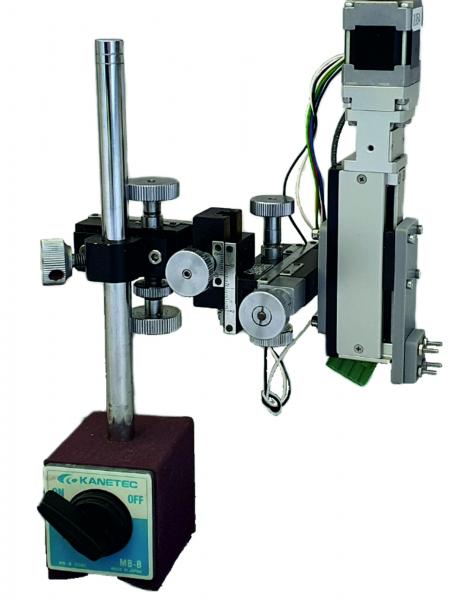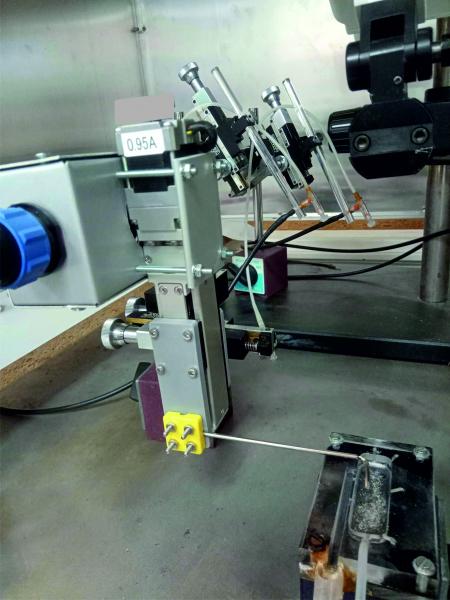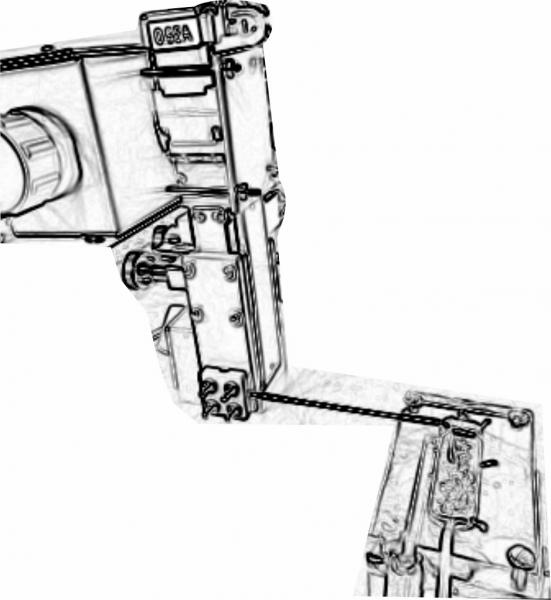Section:

KEYWORDS
- mechanobiology
- impactor
- mechanical stimulation
- spinal cord
- impact damage
The present invention relates to a device for mechanical stimulation of biological material and the related process. It is a micro-impactor for striking or exerting pressure on a biological sample. The device is particularly suitable for in vitro experiments in the field of mechanobiology and for the purpose of recreating conditions resulting from immediate (e.g., traumatic injury to the spinal cord or brain) or progressive (e.g., slow formation of compressive neoplastic masses) physical compression.
SCIENTIFIC BACKGROUND
The consequences of pressure and trauma on organs and tissues (in particular on the brain or spinal cord) have long been studied in preclinical models through the use of impactors, i.e. devices with a rod the end of which is used to strike well-defined parts of anaesthetised animals. Various instrumental measures are used to assess the consequences on the nervous system or other animal tissue, but only after the damage has occurred.
The disadvantages of the already existing impactors are several: they have a size that cannot be integrated into experimental set-ups with in vitro biological material; they cause electrical interference during their operation hindering the simultaneous use of measuring instruments with electromagnetic components; they are equipped with a jerky hydraulic piston, or gravity fall, to actuate the rod that impinges on the target tissue and therefore cannot produce graduated and continuous mechanical forces such as those exerted by a slight but progressive compression; they can only be used on in vivo animals that, although sedated for the duration of the trauma, can still suffer from the procedure once awake.
In addition, at present, there are no impactors that could be used on in vitro biological material and that would allow the adoption of real-time recording tools to follow the very first dynamics of the basic mechanisms of a traumatic injury (shock).
Thus, there is the need to create a new device for mechanically stimulating biological material, in particular in vitro samples, and which can overcome at least one of the drawbacks of current devices. For the purpose, it is necessary to solve the technical problem of taking measurements on an in vitro biological material during or immediately after a graded impact performed on the same biological material.
TECHNICAL FEATURES
The micro-impactor comprises a small body, an actuator driven by a connected controller and a contact organ, movable along the body to strike the target. The contact organ comprises a contact end, a variable length spacer portion connected to both the contact end and the body of the device to keep them separate, and a contact surface that can be varied in shape and size according to experimental requirements.
The device also includes means of power supply that can be connected to an electrical power source.
The stimulation device is advantageously realised with a design and a choice of electrical and electronic components that minimise the electrostatic interference generated by its operation. While connected to other sensors for measurements and data recording, the stimulation device can thus be used to mechanically stimulate a biological in vitro sample. In particular, the stimulation device allows to measure the parameters of a sample during or immediately after an impact.
The actuator used allows the contact organ to be actuated in a very wide range of speeds, forces and durations of impact, to recreate even minimal compressions over time.


EVIDENCE / RESULTS
A fully functioning prototype has already been realised, which in its year of validation at the Laboratory of Applied Neurophysiology and Neuropharmacology, SISSA-IMFR, was used to recreate calibrated lesions of the isolated spinal cord in biological preparations of new-born rodents. Electrophysiological recordings and histological and immunohistochemical analysis of the tissue confirmed the reproducibility of the impact, indicating it as an excellent and original experimental tool for monitoring the dynamics of neuronal electrical activity and cell death processes during traumatic physical injuries.
Laboratory research has shown that the device allows multiple impact characteristics to be programmed, such as: striker displacement, acceleration, deceleration, descending and ascending velocity, duration of stay at the site of maximum displacement and with the additional possibility to recreate successive impacts, even with different parameters, in series.
TRL level: 4 (Laboratory Validated Technology)
POSSIBLE APPLICATIONS
From a commercial and exploitation point of view, the preliminary investigations carried out – also by directly contacting companies and distributors in the sector that have been operating on the Italian market for years – indicate that the target market of laboratory instrumentation, in particular that of experimental set-ups where the present invention fits in, is a niche market populated by a small number of large international players (manufacturers) with strong and capillary distribution networks.
The main target companies therefore are:
– Medical instrument manufacturers
– Hospitals, clinics
– Laboratories
ADVANTAGES
The advantages of the present invention are:
– the mechanical stimulation of biological material in a highly reproducible manner, with the possible integration into the measurement and recording unit of known experimental set-ups for biological material in vitro;
– the regulation of the impact over a wide range of velocities, to allow the force and duration of the impact to be adjusted;
– the possibility to develop a procedure to mechanically stimulate biological materials, to collect missing knowledge on the impact on the nervous system;
– the programming of multiple impact characteristics such as: displacement of the striker, acceleration, deceleration, rate of descent and ascent, duration of stay at the site of maximum displacement, and with the additional possibility of reproducing successive impacts, even with different parameters, in series;
– thanks to its modularity, it can be installed in any imaging or electrophysiology set-up and used in various research fields.
INVENTORS: Giuliano Taccola, John Fischetti
RELATED ARTICLE: A Focal Traumatic Injury to the Neonatal Rodent Spinal Cord Causes an Immediate and Massive Spreading Depolarization Sustained by Chloride Ions, with Transient Network Dysfunction | Cellular and Molecular Neurobiology, published on Springer Nature on the 2nd January 2025


